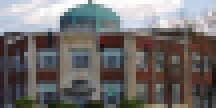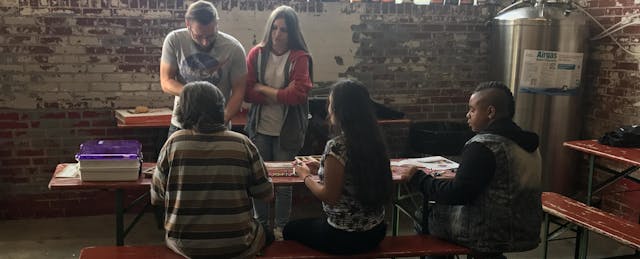I met Trevor (name has been changed) when he was a high school senior in 2014. From a coal mining family in western Kentucky, he’d just suffered a major family crisis and his mother was struggling with mental illness. Understandably, his grades were beginning to suffer and he was missing class regularly.
At the time, I was the homeless education program manager for Paducah Independent Schools District in Paducah, Kentucky. Trevor’s teacher pulled me aside, concerned and frustrated. She filled me in on the particulars. He was struggling scholastically, experiencing a difficult situation at home, and was at risk of falling between the cracks at the worst possible time: just on the verge of adulthood.
But then his teacher added, “He’s always tinkering with the computers in our classroom.”
Coincidentally, as part of another role I had with the district to develop relationships with the business community, I was organizing a field trip to a tech company. At the time, I was in the process of developing a program called “The Tech Pipeline” that allowed local, fast-growing technology companies to connect with prospective talent in the community through our schools. These companies were eager for qualified young candidates to fill positions. Though somewhat ironically, the local unemployment rate was soaring and kids were abandoning the region in search of work.
Clearly, there was a disconnect.
Trevor was hesitant to tag along with a class he didn’t know for the field trip, but was quickly persuaded by the promise of learning about new technology. By the the second hour of the trip, he had connected with a programmer at the company. And by the end of the day, Trevor had met with some college representatives who were able to help him envision and map out a future that would include his passion for technology. Finally, Trevor had a plan and some options as he headed toward graduation.

Our situation is not that unique for rural communities—neither is the story of one youth getting lost in the system. Economically disadvantaged students tend to lack exposure to experiences that nudge them toward building future stories as say, a software engineer or an inventor of the next biomedical innovation. Most of my students lack a personal computer at home or a phone with a consistent data plan—and when 40% of the district’s students are living in poverty, supporting students to envision an attainable career trajectory they can be passionate about requires a unique approach.
In 2015, as the program was launching, I began to have in-depth conversations with emerging industry leaders in our community. They were in search of talent that could communicate effectively and solve problems in a rapidly changing technological environment. As one COO of a cyber security company put it: “I don’t care about the math, we need people who can think and solve challenges we’ve never had before.” I hear this need for creative critical thinkers repeatedly from industry leaders in every sector.
The days of factory work are passing us quickly as most technology can replace the skill sets required for those jobs. Companies are desperate for young employees with the modern skills required to keep their businesses competitive. The “sit and get” style of learning that was good for production line work needs to be replaced with in-person opportunities to actively apply knowledge as solutions to real world problems.
It’s no longer what you know but how you can communicate what you know to make change.
Though many schools and districts are catching on, the reality is that a great deal of our teaching resources go towards activities that drives standardized testing data. Time for projects that focus on building creative and critical thinking skills or developing solutions for real-world problems is scant when your students are already behind in basic academics.
As the program began to gain steam, we started to see our graduates connect meaningfully with local employers through these field trip experiences and internships, and we realized we were on a course to rethink our school district's purpose. We began to see our role as talent generator and economic engine to grow our small town. This was critical for our community as we are now experiencing a declining population and a significant talent gap. Every emerging industry reports consistent job openings for skilled labor but lacks qualified respondents to fill them.
One tech company and a local university were willing to take action to solve the problem. We worked together to fashion a plan that would give students exposure to tech opportunities and experiences, from kindergarten to career. Our first step was to build an ecosystem that included higher education partners and professional advisors. Then we collaborated to design a program including field trips, guest speakers, technology clubs, summer camps, internships and career mentors.
The missing piece of the puzzle was a physical space in the community where this kind of skill development could take place.
When the state of Kentucky Work Ready Initiative announced $100 million in funding for game changing workforce solutions, we jumped on the opportunity to apply for a grant. In 2016, our district won $3.8 million to construct a new 21st century vocational facility—a community makerspace that would allow for multi-generational learning, mentoring around shared curiosity and collaborative problem solving.
The space, operating as a nonprofit inside a school facility, plans to serve learners in three ways. High school students and teachers will have a schedule for visiting the space to access new equipment and to consult with experts that can support with their current projects. Elementary and middle school students will be able to attend field trips and summer camp programs at the space to gain exposure to project-based learning experiences with high-tech tools. Additionally, there will be programming for community members of all ages that takes place after school hours to develop skills such as printing, robotics, and design thinking for product development.
We like to think of it as a souped-up public library with tech tools instead of books. And while the vocational experience will still offer pathways into traditional trades such as welding, carpentry, and auto tech, it will now include a digital emphasis by incorporating classes in information technology, design engineering, fabrication and more. The makerspace will allow visitors to explore the intersections of all the disciplines.
Our vision is strong but we know that bringing it to life will take a large community effort. We are still in the planning phase, and it will take an estimated three years for our new facility to be constructed. In the meantime, we are building a prototype, which we call our “makerspace incubator,” to experiment with programming and implementation, gain exposure and engage the community. The incubator will be located in a historic Coca Cola bottling factory set in the center of our community within walking distance of elementary, middle and high schools.

The ultimate purpose of school is to develop citizens that can make meaningful contributions to society. To do this, we need to spend time reflecting on what inspires and intrinsically motivates our students—and find ways to foster their passions. That is easier said than done, especially with competing priorities like standardized test preparation and an increasing amount of data collection.
But once we view our students as more than a data point, we can begin to see our schools as more than a spreadsheet of percentages. We can begin to reimagine our schools as places of inspiration, connection and opportunity that are critical force multipliers for community growth. We can begin to recognize that kids like Trevor, who are forever tinkering with tech equipment, aren’t problems to be solved, but rather the future of our communities.


